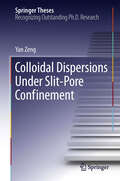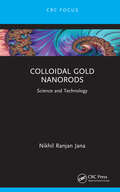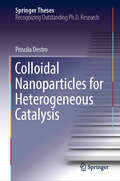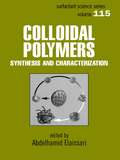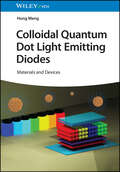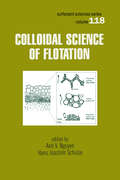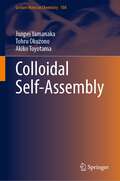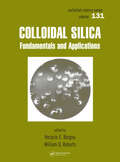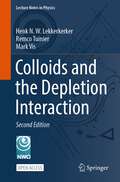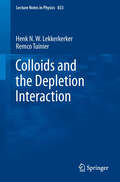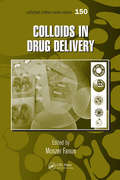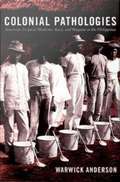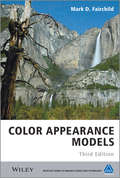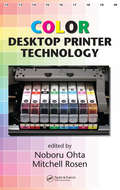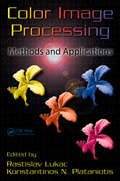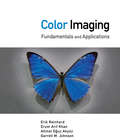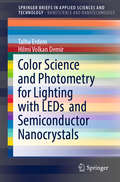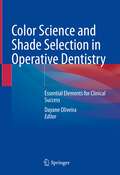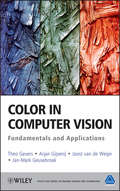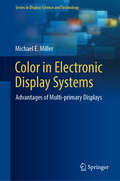- Table View
- List View
Colloidal Dispersions Under Slit-Pore Confinement (Springer Theses)
by Yan ZengThis dissertation contributes to the understanding of fundamental issues in the highly interdisciplinary field of colloidal science. Beyond colloid science, the system also serves as a model for studying interactions in biological matter. This work quantitatively investigated the scaling laws of the characteristic lengths of the structuring of colloidal dispersions and tested the generality of these laws, thereby explaining and resolving some long-standing contradictions in literature. It revealed the effect of confinement on the structuring, independently of specific properties of the confining interfaces. In addition, it resolved the influence of roughness and charge of the confining interfaces on the structuring and as well providing a method to measure the effect of surface deformability on colloidal structuring.
Colloidal Gold Nanorods: Science and Technology
by Nikhil Ranjan JanaThis book covers the synthesis and applications of colloidal gold nanorods including their properties, approaches for various chemical synthesis, and different gold nanorod-based nanocomposites with their properties and application potentials. Furthermore, it covers the surface chemistry and functionalization of gold nanorods for numerous biomedical applications. Various applications of gold nanorods including optical probes, dark filed contrast agents, photothermal therapy agents, and plasmonic photocatalyst are covered, along with the toxicological aspects. Features: Covers all aspects of gold nanorods along with selected protocols Focuses on synthetic chemistry, optical property, and functionalization approach of colloidal gold nanorods Describes standard synthetic methods and advantages of gold nanorods in biomedical applications Includes authentic and reproducible experimental procedures Discusses applications like redox catalysts, catalyst promoters, delivery carriers, solar cell materials, and so forth This book aims at graduate students and researchers interested in nanotechnology and gold nanoparticles.
Colloidal Nanoparticles for Heterogeneous Catalysis (Springer Theses)
by Priscila DestroThis book explores the formation of colloidal gold–copper (AuCu) alloy nanoparticles and evaluate their application in heterogeneous catalysis. Metal alloys are extremely versatile materials that have been used since the Antiquity to improve the properties of commonly used metals, therefore the understanding of their properties has fostered the applications in areas such as photonics, sensors, clinical diagnostics, and especially in heterogeneous catalysis, which allows catalyst active sites to be modulated.In this book, readers will appreciate the fundamental aspects involved in the synthesis of AuCu nanoalloys, including real-time information about their atomic organization, electronic properties, as well a deeper understand about the behavior of AuCu supported nanoalloys under real catalytic conditions, providing interesting insights about the effect of the support on the nanoalloy stability. The results presented here open new horizons for using metal alloys in catalysis and also other areas where the metal–support interface may play a crucial role.
Colloidal Polymers: Synthesis and Characterization (Surfactant Science #Vol. 115)
by Abdelhamid ElaissariAmidst developments in nanotechnology and successes in catalytic emulsion polymerization of olefins, polymerization in dispersed media is arousing an increasing interest from both practical and fundamental points of view. This text describes ultramodern approaches to synthesis, preparation, characterization, and functionalization of latexes, nanopa
Colloidal Quantum Dot Light Emitting Diodes: Materials and Devices
by Hong MengColloidal Quantum Dot Light Emitting Diodes Explore all the core components for the commercialization of quantum dot light emitting diodes Quantum dot light emitting diodes (QDLEDs) are a technology with the potential to revolutionize solid-state lighting and displays. Due to the many applications of semiconductor nanocrystals, of which QDLEDs are an example, they also hold the potential to be adapted into other emerging semiconducting technologies. As a result, it is critical that the next generation of engineers and materials scientists understand these diodes and their latest developments. Colloidal Quantum Dot Light Emitting Diodes: Materials and Devices offers a comprehensive introduction to this subject and its most recent research advancements. Beginning with a summary of the theoretical foundations and the basic methods for chemically synthesizing colloidal semiconductor quantum dots, it identifies existing and future applications for these groundbreaking technologies. The result is tailored to produce a thorough understanding of this area of research. Colloidal Quantum Dot Light Emitting Diodes readers will also find: An author with decades of experience in the field of organic electronics Detailed discussion of topics including advanced display technologies, the patent portfolio and commercial considerations, and more Strategies and design techniques for improving device performance Colloidal Quantum Dot Light Emitting Diodes is ideal for material scientists, electronics engineers, inorganic and solid-state chemists, solid-state and semiconductor physicists, photochemists, and surface chemists, as well as the libraries that support these professionals.
Colloidal Quantum Dot Optoelectronics and Photovoltaics
by Gerasimos Konstantatos Edward H. Sargent Gerasimos Konstantatos Edward H. SargentCapturing the most up-to-date research in colloidal quantum dot (CQD) devices, this book is written in an accessible style by the world's leading experts. The application of CQDs in solar cells, photodetectors and light-emitting diodes (LEDs) has developed rapidly over recent years, promising to transform the future of clean energy, communications, and displays. This complete guide to the field provides researchers, students and practitioners alike with everything they need to understand these developments and begin contributing to future applications. Introductory chapters summarise the fundamental physics and chemistry, whilst later chapters review the developments that have propelled the field forwards, systematically working through key device advances. The science of CQD films is explained through the latest physical models of semiconductor transport, trapping and recombination, whilst the engineering of organic and inorganic multilayered materials is shown to have enabled major advances in the brightness and efficiency of CQD LEDs.
Colloidal Science of Flotation (Surfactant Science #118)
by Ahn Nguyen Hans Joachim SchulzeKeeping pace with explosive developments in the field, Colloidal Science of Flotation reviews and updates the fundamentals of the bubble-particle collection phenomenon using a self-consistent approach that helps readers understand the hydrodynamic aspects of bubble-particle collection. The authors examine bubble rise velocity, water velocity around air bubbles, the thinning of intervening liquid films, the stability of particle-bubble aggregates, and macroscopic processes in froth. They also survey the applicability of emerging technologies in industrial flotation deinking, wastewater treatment, flotation of plastics, and improvements in minerals and coal flotation.
Colloidal Self-Assembly (Lecture Notes in Chemistry #108)
by Junpei Yamanaka Tohru Okuzono Akiko ToyotamaThis concise book covers fundamental principles of colloidal self-assembly and overviews of basic and applied research in this field, with abundant illustrations and photographs. Experimental and computer simulation methods to study the colloidal self-assembly are demonstrated. Complementary videos "Visual Guide to Study Colloidal Self-Assembly" on the research procedures and assembly processes are available via SpringerLink to support learning.The book explains basic elements of mechanics and electromagnetism required to study the colloidal self-assembly, so that graduate students of chemistry and engineering courses can learn the contents on their own. It reviews important research topics, including the authors' works on the colloidal self-assembly of more than 30 years’ work. The principal topics include: (1) crystallization of colloidal dispersions, with the emphasis on the role of surface charges, (2) fabrication of large and high-quality colloidal crystals by applying controlled growth methods, (3) association and crystallization by depletion attraction in the presence of polymers, (4) clustering of colloidal particles, especially those in oppositely charged systems, and (5) two-dimensional colloidal crystals. Furthermore, it covers (6) applications of colloidal crystals, ranging from cosmetics to sensing materials. We also describe space experiments on colloidal self-assembly in the International Space Station.This book will interest graduate school students in colloid and polymer science, pharmaceutics, soft matter physics, material sciences, and chemical engineering courses. It will also be a useful guide for individuals in academia and industry undertaking research in this field.
Colloidal Silica: Fundamentals and Applications (Surfactant Science #131)
by Horacio E. Bergna William O. RobertsIn spite of the apparent simplicity of silica's composition and structure, scientists are still investigating fundamental questions regarding the formation, constitution, and behavior of colloidal silica systems. Colloidal Silica: Fundamentals and Applications introduces new information on colloid science related to silica chemistry as well
Colloidal Suspension Rheology
by Jan Mewis Norman J. WagnerColloidal suspensions are encountered in a multitude of natural, biological and industrially relevant products and processes. Understanding what affects the flow behavior, or rheology, of colloid particles, and how these suspensions can be manipulated, is important for successful formulation of products such as paint, polymers, foods and pharmaceuticals. This book is the first devoted to the study of colloidal rheology in all its aspects. With material presented in an introductory manner, and complex mathematical derivations kept to a minimum, the reader will gain a strong grasp of the basic principles of colloid science and rheology. Beginning with purely hydrodynamic effects, the contributions of Brownian motion and interparticle forces are covered, before the reader is guided through specific problem areas, such as thixotropy and shear thickening; special classes of colloid suspensions are also treated. An essential guide for academic and industrial researchers, this book is also ideal for graduate course use.
Colloids and the Depletion Interaction (Lecture Notes in Physics #1026)
by Remco Tuinier Henk N.W. Lekkerkerker Mark VisThis open access book provides a detailed exploration of the phase behaviour of, and interfacial properties in, complex colloidal mixtures (e.g., clay, milk, blood). Insights into colloids have been at the heart of many innovations in different industries. The big question underlying these innovations is how can colloidal systems be formulated and designed towards the desired properties? To do this, the forces between the colloidal particles need to be controlled. Adding depletants (non-adsorbing polymers or small colloids) is key to controlling the attractive interactions. Colloids and the Depletion Interaction provides the qualitative insights and quantitative tools to understand and predict such forces in colloidal dispersions. It offers a concise introduction to the history and fundamentals of the depletion interaction in, and phase behaviour of, colloidal dispersions.Why does adding polymers lead to attractive forces between colloidal particles? What determines the phase stability of multi-component colloidal systems? These include colloid—polymer mixtures, binary colloidal mixtures, and anisotropic particles such as clay platelets, cubes and rod-like viruses. Conceptual explanations are accompanied by experimental and computer simulation results throughout. Illustrations of depletion effects in colloid science, biology and technology demonstrate its wider significance. The concluding outlook provides the scope of challenges and possibilities in this exciting field of science. This second updated and enlarged edition contains 12 Chapters. It is an ideal book for advanced undergraduates and graduate students in physical chemistry, chemical engineering and soft matter physics. Besides providing a fundamental understanding of depletion interactions in colloidal mixtures, it gives background information on colloidal stability and phase behaviour in general. For experienced scientists and engineers working on mixtures of colloids and non-adsorbing (bio)polymers or colloidal particles, this book serves as a reference for understanding depletion interactions in systems of their specific interest.
Colloids and the Depletion Interaction (Lecture Notes in Physics #833)
by Remco Tuinier Henk N.W. LekkerkerkerColloids are submicron particles that are ubiquitous in nature (milk, clay, blood) and industrial products (paints, drilling fluids, food). In recent decades it has become clear that adding depletants such as polymers or small colloids to colloidal dispersions allows one to tune the interactions between the colloids and in this way control the stability, structure and rheological properties of colloidal dispersions. This book offers a concise introduction to the fundamentals of depletion effects and their influence on the phase behavior of colloidal dispersions. Throughout the book, conceptual explanations are accompanied by experimental and computer simulation results.
Colloids in Drug Delivery (Surfactant Science)
by Monzer FanunColloidal drug delivery systems present a range of therapeutic benefits in the treatment of a number of challenging conditions, allowing researchers to cross barriers that have previously prevented efficient treatment while offering improved and more targeted absorption. Summarizing recent research in the field, Colloids in Drug Delivery assembles
Colloquy on Minority Males in Science, Technology, Engineering, and Mathematics
by Catherine DidionOn August 8-12, 2010 the National Academy of Engineering (NAE), with funding from the National Science Foundation (NSF), convened the Colloquy on Minority Males in Science, Technology, Engineering, and Mathematics (STEM), following the release of several reports highlighting the educational challenges facing minority males. The NSF recognized the need to gather input from research communities that focus on minority males about how to frame investigations of gender-based factors that impact learning and choice in STEM education (both at the precollege and higher education levels) and the workforce for minority males. There was particular interest in framing a research agenda to study how interactions between minority males and societal and educational systems (both formal and informal) encourage or discourage the young men's interest and persistence in STEM. In addition, NSF hoped to gain community input to inform the parameters of a future NSF research program that could effectively address minority male participation in STEM. The Colloquy was held at the Mt. Washington Conference Center in Baltimore, Maryland, with approximately 40 participants, most of them researchers in education, psychology, sociology, mathematics, and physics. Colloquy on Minority Males in Science, Technology, Engineering, and Mathematics presents a summary of the Colloquy's breakout and plenary discussions, which addressed (a) research questions articulated in the breakout groups together with theories and methodologies to begin to address these questions; and (b) considerations for a potential research solicitation for the NSF, with major areas of inquiry concerning access, participation, and success for minority males in STEM. This report reflects the views of the individuals who participated in the plenary and breakout groups. It has been reviewed in draft form by persons chosen for their diverse perspectives and expertise in accordance with procedures approved by the National Academies' Report Review Committee. The purpose of this independent review is to provide candid and critical comments that will assist the institution in making its published report as sound as possible and to ensure that the report meets institutional standards for quality and objectivity.
Colonial Farms
by Verna FisherWhat kinds of food were grown on colonial farms? Did the colonists have farm animals? Why did farm life vary from one area of the country to another? How did colonial farms compare to farms of the Native Americans? Find out the answers to these questions and more.
Colonial Pathologies: American Tropical Medicine, Race, and Hygiene in the Philippines
by Warwick AndersonColonial Pathologies is a groundbreaking history of the role of science and medicine in the American colonization of the Philippines from 1898 through the 1930s. Warwick Anderson describes how American colonizers sought to maintain their own health and stamina in a foreign environment while exerting control over and "civilizing" a population of seven million people spread out over seven thousand islands. In the process, he traces a significant transformation in the thinking of colonial doctors and scientists about what was most threatening to the health of white colonists. During the late nineteenth century, they understood the tropical environment as the greatest danger, and they sought to help their fellow colonizers to acclimate. Later, as their attention shifted to the role of microbial pathogens, colonial scientists came to view the Filipino people as a contaminated race, and they launched public health initiatives to reform Filipinos' personal hygiene practices and social conduct. A vivid sense of a colonial culture characterized by an anxious and assertive white masculinity emerges from Anderson's description of American efforts to treat and discipline allegedly errant Filipinos. His narrative encompasses a colonial obsession with native excrement, a leper colony intended to transform those considered most unclean and least socialized, and the hookworm and malaria programs implemented by the Rockefeller Foundation in the 1920s and 1930s. Throughout, Anderson is attentive to the circulation of intertwined ideas about race, science, and medicine. He points to colonial public health in the Philippines as a key influence on the subsequent development of military medicine and industrial hygiene, U. S. urban health services, and racialized development regimes in other parts of the world.
Colonialism and Christianity in Mandate Palestine
by Laura RobsonDrawing on a rich base of British archival materials, Arabic periodicals, and secondary sources, Colonialism and Christianity in Mandate Palestine brings to light the ways in which the British colonial state in Palestine exacerbated sectarianism. By transforming Muslim, Christian, and Jewish religious identities into legal categories, Laura Robson argues, the British ultimately marginalized Christian communities in Palestine. Robson explores the turning points that developed as a result of such policies, many of which led to permanent changes in the region's political landscapes. Cases include the British refusal to support Arab Christian leadership within Greek-controlled Orthodox churches, attempts to avert involvement from French or Vatican-related groups by sidelining Latin and Eastern Rite Catholics, and interfering with Arab Christians' efforts to cooperate with Muslims in objecting to Zionist expansion. Challenging the widespread but mistaken notion that violent sectarianism was endemic to Palestine, Colonialism and Christianity in Mandate Palestine shows that it was intentionally stoked in the wake of British rule beginning in 1917, with catastrophic effects well into the twenty-first century.
Color Appearance Models
by Mark D. FairchildThe essential resource for readers needing to understand visual perception and for those trying to produce, reproduce and measure color appearance in various applications such as imaging, entertainment, materials, design, architecture and lighting.This book builds upon the success of previous editions, and will continue to serve the needs of those professionals working in the field to solve practical problems or looking for background for on-going research projects. It would also act as a good course text for senior undergraduates and postgraduates studying color science.The 3rd Edition of Color Appearance Models contains numerous new and expanded sections providing an updated review of color appearance and includes many of the most widely used models to date, ensuring its continued success as the comprehensive resource on color appearance models.Key features:Presents the fundamental concepts and phenomena of color appearance (what objects look like in typical viewing situations) and practical techniques to measure, model and predict those appearances.Includes the clear explanation of fundamental concepts that makes the implementation of mathematical models very easy to understand.Explains many different types of models, and offers a clear context for the models, their use, and future directions in the field.
Color Desktop Printer Technology
by Noboru Ohta Mitchell RosenPrinting traces its roots back for centuries, and the invention of moveable type changed the world. However, until the advent of the computer, printing remained a costly and time-consuming operation. From the first humble dot matrix to modern inkjet, laser, and dye sublimation printers, desktop printing has brought low-cost, high quality printing out of the large presses and into the home and office. Color Desktop Printer Technology provides an overview of the current state of the technology, examining both current and emerging applications.With expert contributors from leading companies and universities in the US and Japan, this book examines the color desktop printer from every angle. It begins with an introduction to the basic principles of color printing and the concepts of document and image quality. An overview of the historical background, current trends, and future directions places the technology in its business and market context. The book then devotes four chapters to the major platform: inkjet, laser printer, thermal transfer, and film recording. The last two chapters focus on color management and the quickly developing spectral printing technology.Laying a foundation for continued development and innovation in this ubiquitous field, Color Desktop Printer Technology is fundamental enough to be enjoyed by interested laypersons, yet detailed enough to satisfy the practicing engineer.
Color Image Processing: Methods and Applications (Image Processing Series)
by Rastislav Lukac Konstantios N. PlataniotisColor Image Processing: Methods and Applications embraces two decades of extraordinary growth in the technologies and applications for color image processing. The book offers comprehensive coverage of state-of-the-art systems, processing techniques, and emerging applications of digital color imaging. To elucidate the significant progress in specialized areas, the editors invited renowned authorities to address specific research challenges and recent trends in their area of expertise. The book begins by focusing on color fundamentals, including color management, gamut mapping, and color constancy. The remaining chapters detail the latest techniques and approaches to contemporary and traditional color image processing and analysis for a broad spectrum of sophisticated applications, including:Vector and semantic processingSecure imagingObject recognition and feature detectionFacial and retinal image analysisDigital camera image processingSpectral and superresolution imagingImage and video colorizationVirtual restoration of artworkVideo shot segmentation and surveillanceColor Image Processing: Methods and Applications is a versatile resource that can be used as a graduate textbook or as stand-alone reference for the design and the implementation of various image and video processing tasks for cutting-edge applications. This book is part of the Digital Imaging and Computer Vision series.
Color Imaging: Fundamentals and Applications
by Erik Reinhard Erum Arif Khan Ahmet Oguz Akyuz Garrett JohnsonThis book provides the reader with an understanding of what color is, where color comes from, and how color can be used correctly in many different applications. The authors first treat the physics of light and its interaction with matter at the atomic level, so that the origins of color can be appreciated. The intimate relationship between energy
Color Science and Photometry for Lighting with LEDs and Semiconductor Nanocrystals (SpringerBriefs in Applied Sciences and Technology)
by Hilmi Volkan Demir Talha ErdemThis book reviews the application of semiconductor nanocrystals also known as colloidal quantum dots (QDs) to LED lighting for indoors and outdoors as well as LED backlighting in displays, summarizing the color science of QDs for lighting and displays and presenting recent developments in QD-integrated LEDs and display research. By employing QDs in color-conversion LEDs, it is possible to simultaneously accomplish successful color rendition of the illuminated objects and a good spectral overlap between the emission spectrum of the light source and the sensitivity of the human eye at a warm white color temperature – something that is fundamentally challenging to achieve with conventional sources, such as incandescent and fluorescent lamps, and phosphor-based LEDs.
Color Science and Shade Selection in Operative Dentistry: Essential Elements for Clinical Success
by Dayane OliveiraThis comprehensive guide to color science and shade selection in Dentistry presents all the theory and clinical guidance required in order to achieve consistent clinical success. The book opens by reviewing color and its dimensions and discussing color perception, drawing attention to the various phenomena that impact upon it. Shade selection in Operative Dentistry is then explained in detail with the aid of copious illustrations. The coverage encompasses shade selection methods for resin-based composite restorations and for bleaching procedures, with presentation of the latest evidence on their accuracy and reliability. Guidance is then provided on how to achieve predictable color harmony between the natural tooth and the composite restorative material in the context of biomimetic Dentistry, with discussion of special effects, pigments, layering techniques, surface texture, and finishing and polishing. Changes in color over time and responses to such changes are also outlined. The book will be of value for practitioners in Restorative and Esthetic Dentistry as well as for dental students and researchers.
Color in Computer Vision: Fundamentals and Applications (The Wiley-IS&T Series in Imaging Science and Technology #23)
by Arjan Gijsenij Jan-Mark Geusebroek Theo Gevers Joost van de WeijerWhile the field of computer vision drives many of today’s digital technologies and communication networks, the topic of color has emerged only recently in most computer vision applications. One of the most extensive works to date on color in computer vision, this book provides a complete set of tools for working with color in the field of image understanding. Based on the authors’ intense collaboration for more than a decade and drawing on the latest thinking in the field of computer science, the book integrates topics from color science and computer vision, clearly linking theories, techniques, machine learning, and applications. The fundamental basics, sample applications, and downloadable versions of the software and data sets are also included. Clear, thorough, and practical, Color in Computer Vision explains: Computer vision, including color-driven algorithms and quantitative results of various state-of-the-art methods Color science topics such as color systems, color reflection mechanisms, color invariance, and color constancy Digital image processing, including edge detection, feature extraction, image segmentation, and image transformations Signal processing techniques for the development of both image processing and machine learning Robotics and artificial intelligence, including such topics as supervised learning and classifiers for object and scene categorization Researchers and professionals in computer science, computer vision, color science, electrical engineering, and signal processing will learn how to implement color in computer vision applications and gain insight into future developments in this dynamic and expanding field.
Color in Electronic Display Systems
by Michael E. MillerThis book explores the principles, design, and image processing of multi-primary displays, and introduces the reader to the intricacies of the typical imaging pathways which influence display design and the perception of color within a display system. Early chapters introduce the concepts behind human perception, color science, and lighting, which are necessary to fully understand multi-primary displays. The reader is also introduced to digital capture and transmission systems to better understand the ecosystem in which multi-primary displays exist. Subsequent chapters introduce the reader to current display technologies, including LCD, OLED, and inorganic LED displays. The working principles, performance, and upcoming advances are discussed for each of these technologies to provide the reader with a clear understanding of the tradeoffs which are necessary when considering multi-primary displays. This discussion is followed by an in-depth discussion of the image processing technology necessary to implement multi-primary displays. The book concludes with chapters that clearly discuss the advantages and limitations of multi-primary displays for direct view, virtual reality, and augmented reality displays. The book provides a broad viewpoint across the entire display ecosystem, explaining the interactions among system components to provide a rationale for the further development of multi-primary displays. Whether the reader is interested in broadening their understanding of display systems or the development of multi-primary displays, the text provides and understandable and practical summary of important display system concepts.
